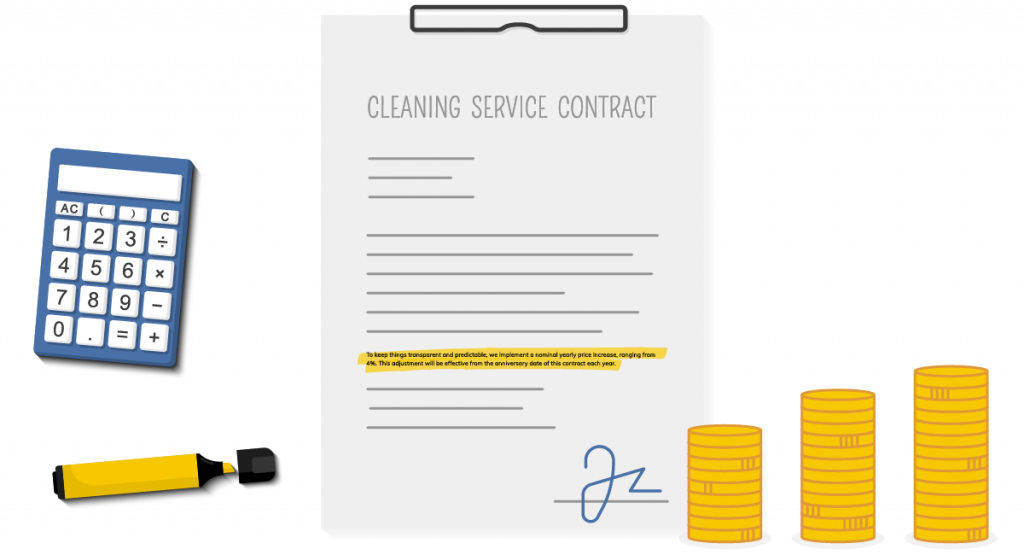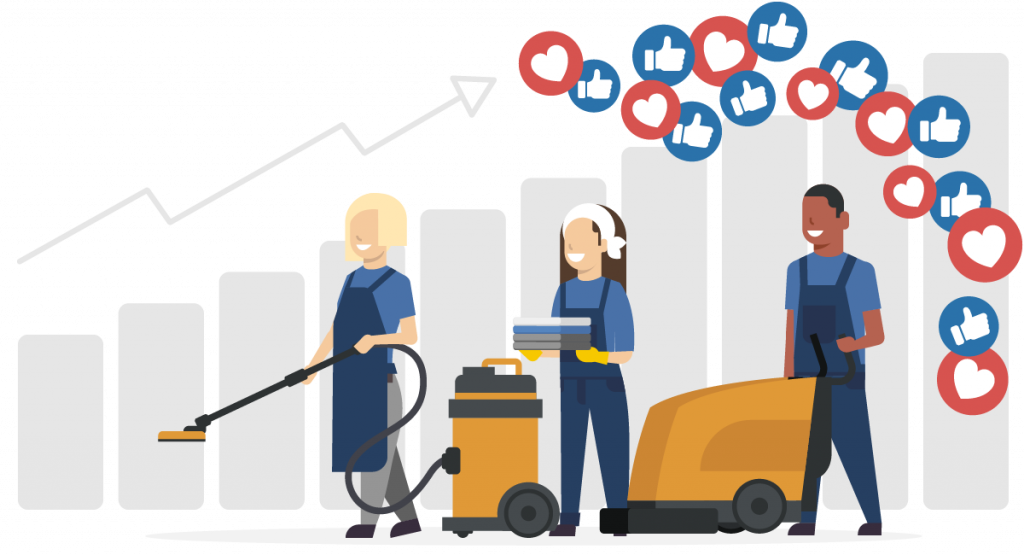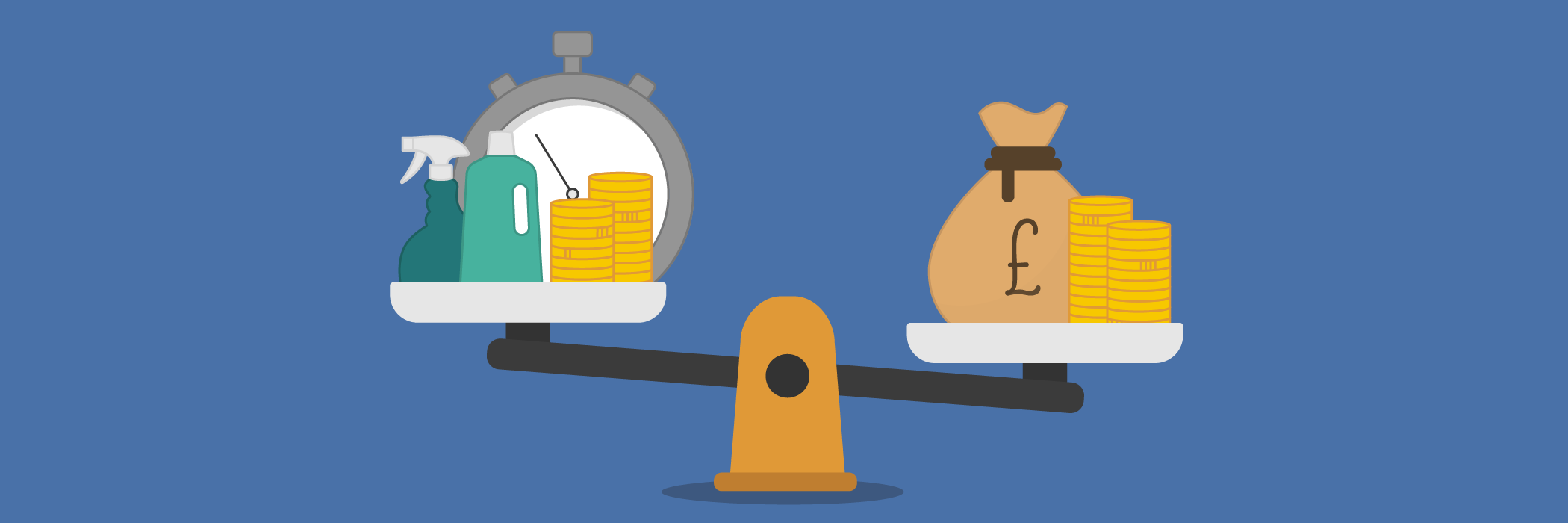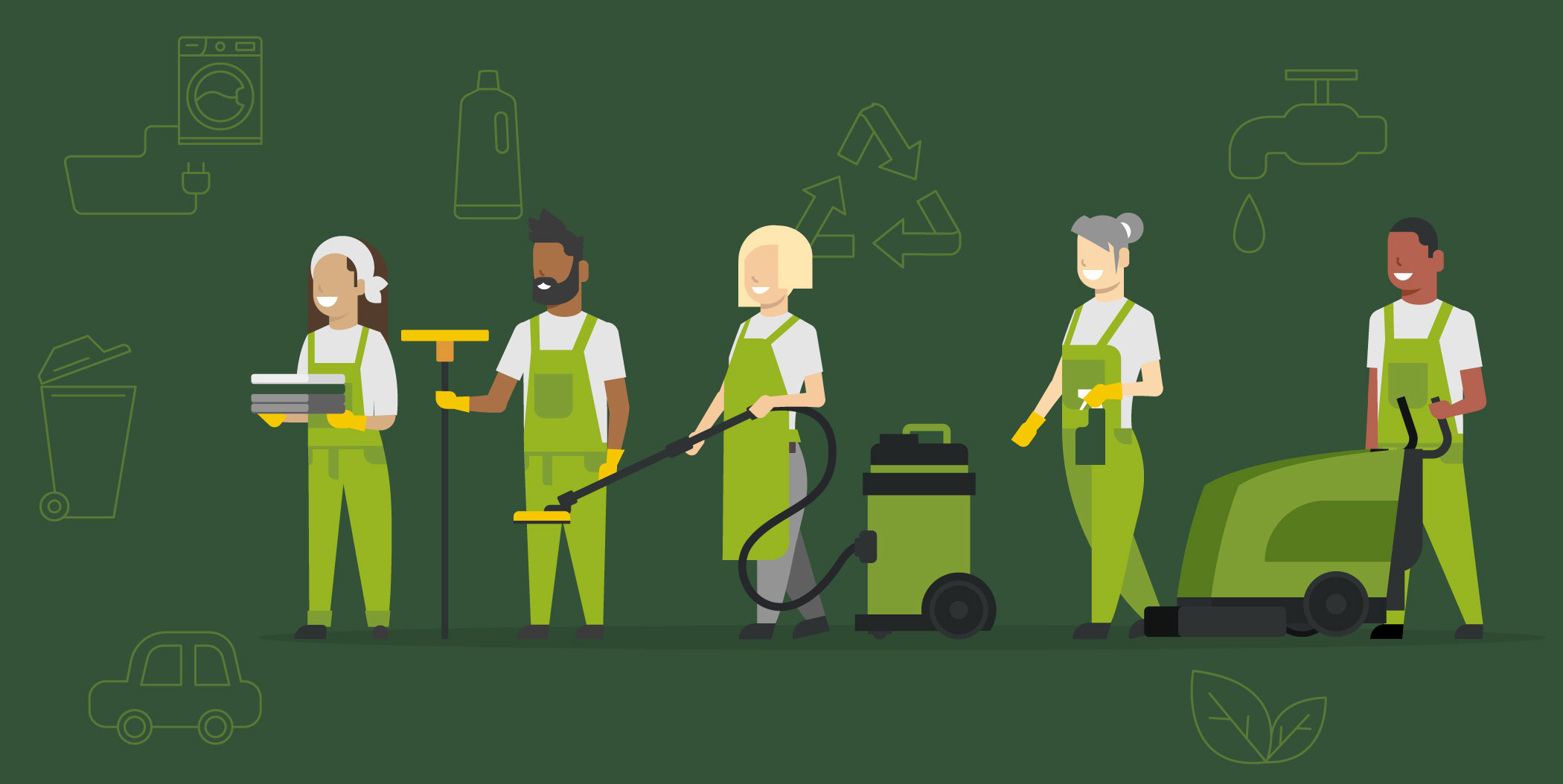Setting the right cleaning price for a client can be a daunting task. What if they choose a cheaper competitor, or I underbid myself? The reality is that inflation, a rise in wage, and unforeseen expenses may force you, at some point, to raise your service price. In this article, we guide you on how to have a successful conversation about price increases with your client, and how improvements in your cleaning business can be arguments for said price raise.
Why Raising Rates are Critical for Your Business’ Survival: A Deep Dive into the UK Economic Landscape
Many events have affected the UK economy during the past few years, with increases in various expenses. As a consequence, every cleaning business needs to reevaluate and set the right cleaning price to continue earning a sustainable profit.
The Political Influence on the Cleaning Industry’s Economy
An immediate reason for raising and setting the right cleaning service price now is the increase in the National Living Wage, effective April 2024. The UK Government has increased the national living wage by almost 10%, in pounds, from £10.42 to £11.44. Even if you paid your staff more than this, the general rise creates pressure to maintain a competitive pay gap. Retaining valuable employees is essential, and the key is to offer a competitive salary. This can ensure staff satisfaction and loyalty in a challenging market.
On top of this, the Home Secretary announced that the Home Office will change the rules for migrant families and the access to work VISA. All in an effort to reduce immigration.
To put it into perspective, a quarter of workers in the cleaning sector are migrants, but in London alone, the percentage is a stunning 68 percent, according to Trust for London. The cleaning business supports migrants by integrating them into England and its workforce. However, migrants create just as much value. They comprise a high percentage of the workforce, and are needed to uphold the high cleaning standard today. The cleaning industry depends on them, because otherwise there might not be enough staff to hire at all.
An unfortunate outcome of the changes in VISA rules could be fewer migrants to hire. Therefore, attaining current migrants, would demand higher wages. There would also be a need to hire more ethnic Britons. Their social and educational advantage in society would make them expect a higher wage than many unskilled migrants would. The overall outcome would be a general rise in wages and higher than just the rise in the National Living Wage.
The Inflation: How the Economy Affects the Cleaning Industry
Another thing to consider are all the unforeseen expenses that affect the economy, such as the war between Ukraine and Russia. An economical buffer through a slow, but steady rise in your service price would help. According to Statista, the inflation rate was 3.9 percent in November 2023, a decrease from 4.6 in the previous month. But the high prices seem to stay. Here are statistics on the inflation in relevance to the cleaning industry.
- Prices for cleaning supplies have risen 21.8% from 2013 till 2023 according to the Official Data Foundation.
- Data from the Office for National Statistics show transportation costs, a.k.a., motor fuels have decreased 10.6 percent this year as of November 2023, but the price is still higher than a few years ago.
- Numbers from Statista’s show that there has been a rise in the wage of approx. 7.3 percent in October 2023, but only a rise of 1.3 percent when adjusting for inflation.
The Challenges and Fears When it Comes to Price Raising and the Cost of Inaction
The cleaning industry is known to be price-focused. A general concern among owners of cleaning businesses is the fear of losing clients because of prices. Clients might leave because of what they perceive as a “high” service pricing, or from a lower price offer from competitors.
As a cleaning business owner, you might have previously enticed new clients with competitive pricing. But today, the low price might lose you important income, because of inflation and higher prices for commodities. The obvious solution is to raise the price, but doing it without upsetting the client can be a delicate task. A large part of the solution is differentiating yourself from your competitors through other factors than price. Tips on differentiating yourself will be returned to later in this article.
What Would Happen if You Never Raised Your Price?
Let’s imagine a simple scenario. You have a client whose contract and fixed service price were set to £1000 a month. Ten years have passed, and you have not made adjustments to wage- and product expenses. Throughout these years, with inflation and other costs, your client might be an expense today, instead of an income. For example, if those £1000 earned you £200, while the £800 went to expenses, the inflation would slowly decrease your direct earnings. Now see what happens if those wage- and product expenses rose with a total of 4% a year, for ten years.

The calculation is as follows: £800 x (1 + 0.04)^10 = £1184.20. Essentially, if you were making a profit of £200 a month at the start of the contract, you will face an expense of £184 after 10 years. This is due to the contract price remaining the same while your expenses have increased. Let’s examine how the profit declines annually as the expenses rise by 4% each year:
- After 1 year: £168 (profit)
- After 2 years: £134.72 (profit)
- After 3 years: £100.11 (profit)
- After 4 years: £64.11 (profit)
- After 5 years: £26.68 (profit)
- After 6 years: -£12.26 (loss)
- After 7 years: -£52.75 (loss)
- After 8 years: -£94.86 (loss)
- After 9 years: -£138.65 (loss)
- After 10 years: -£184.20 (loss)
As shown, the profit decreases each year and turns into a loss after 6 years due to the costs increasing while the contract price remains the same.
The Consequences of Fixed Prices
If this scenario were to occur, it would leave you with only two options: Raising your price or cutting down on the hours. But cutting down the hours would only lead to a downgrade in the cleaning service. There would not be enough time to offer the same service, and such a downgrade would put you at risk of losing the client.
Even if the real case were more complex and with fluctuating inflation, then the overall result would be the same. Prices rarely decrease to the “old” prices years ago. In the end, you earn less for your cleaning service if you do not raise your prices beforehand.
Why Some Cleaning Companies Succeed at Raising Rates (And Others Don’t)
It is of dire importance to deliver the news of price raises to your clients the right way. The first mistake some make, is not even informing the client and therefore making it an unpleasant surprise. The key is dialogue and, secondly, having documentation and arguments for why and how the service price is rising.
How a Rise in the Cleaning Price Could Be Presented to a Client
Dear client,
In the coming year, we need to improve on X and Y and adjust to Z, in order to provide better service, and it is therefore necessary to increase the service price with 4%. We raise the price, but that is beneficial for you because you receive a better service…
This is but a simple, and unfinished letter. Hopefully, this template can be used as inspiration and be filled with great arguments and reasons for your price raise.

Filling in the X, Y, and Z: The Arguments and Reasoning Behind the Price Raise
Now is the time to discuss solutions and ways to distinguish your business from the competition.
The best way is to highlight what makes you special. If you cannot highlight any specifics, then here are some important service improvements for a better service that deserves a price raise.
Implement New Types of Cleaning
- ECO-friendly or green cleaning.
- Specialised cleaning for items such as towels, curtains, or carpets.
- Deep cleaning → cleaning both often-used areas and areas that are not used as often.
Focus on Optimising the Cleaning Process*
- Connected IoT
- Automation
- ESG
- Software
*Focus points of optimisation is from a recent presentation in December 2023 by CSSA.
The Relation to Your Clients
- More communication and documentation → dialogue is key.
- More quality control visits.
- Show good reviews from satisfied clients to price-focused or sceptical clients.
This all summaries that implementations of varying nature can support your claims about the necessary rise in the service price. However, the obvious arguments would also be adjustments to the Z; the economic changes. Inform them in simple terms about the market, the inflation and the higher wages. This could be reason enough, but highlighting how they receive an improved cleaning service is also critical.
The Ultimate Price Raise Strategy: Adding a Yearly Rise in the Contract or Raise the Hourly Wage

The ultimate advice when it comes to securing a raise in your cleaning service price, is incorporating it in your client’s contract. Make a contract with a yearly rise, everything from 2-4% is a good amount, especially with new contracts, those are the easiest to implement this on. The client will be accustomed to rising prices this way.
It can be daunting to raise prices for a client who has had the same price for many years. Instead of a yearly rise in the contract, then you could change the hourly rate with only £1. Changing it just by £1 would make a significant difference in the bigger picture. It may seem like a small amount, but with 200 hours at a client a month, that is £200 extra a month, which goes directly to the bottom line.
If there is a strained relation with a client, remember to communicate and ask for reviews to improve. If a rise in the cleaning price is off the table, then turn the narrative around and then explain to them why their price is actually a discount when considering the inflation, rising wages etc. This approach not only nurtures understanding but also illustrates the value they gain in today’s economic landscape.
The Risk of Overlooking Invisible Costs and Missing Out on Profit
There are many pitfalls when it comes to expenses in a business, and this is where some fail. Here is a list of some common pitfalls you should avoid when it comes to “invisible” costs.
- Forgetting to add an extra charge for private cleaning
- Forgetting an extra fee for parking or for transport expenses
- Differentiate cleaning supplies from consumer goods → let the client pay for what they actually use of towels, toilet paper etc.
- Extra service charge for towel cleaning etc.
- Environment- or administration charge. OBS: watch out for this one and be sure you know exactly with this fee covers or your client will feel deceived.
- And lastly, expenses such as a physical invoice.
Another useful tip, is adjusting the timing of client payments to better align with your payment dates. This is not a direct increase in profit, but could you help have more control over the finances. It is often the case that a client pays backwards, at the end of the month, where you have to cover the missing income in the meantime. Consider moving the payment to a forward payment, or to the middle of the month.
How the Correct Price Raise Benefits You: Content Clients and a Soaring Surplus

By investing in optimisations of your cleaning service, and have incorporated high quality communication with your client, then you can set the right price and achieve client satisfaction at the same time. Clients will notice and appreciate your efforts and understand your commitment to improve their service experience.
Additionally, keeping track of the cleaning progress and communicating it helps streamline your work and makes it easier to raise prices.
Future challenges become more manageable when you are aware of them. A price increase, which boosts your business’s revenue, can help cover unforeseen or inevitable expenses. By avoiding the usual pitfalls we have mentioned, and incorporating a yearly price rise in the contract, you can ensure a steady profit for your business.
On the level of working environment, then the right price raise could also be a way to avoid stress among your cleaning staff. If the right service price is set, then working hours and wage go hand in hand. The staff avoids more hours for less wage because of better service prices you have negotiated with the clients.
The price raise could also be an opportunity to invest the extra money in automatic optimising of the cleaning process, which makes your cleaning business more competitive on the market. Again, it would help the cleaning staff if there were enough income in the business to add tools and technology, as it makes their jobs less straining and stressful.
Towards a Successful Cleaning Business
Many implementations can be made to improve your cleaning business, but it all depends on the income on the bottom line. Knowing what your service is worth and having a rise in the cleaning price for your clients is essential and is the key to success in the cleaning business. Following the tips and tricks provided here will not only make the price raise easier, but will improve the overall business quality you offer.
If you’re interested in reading more about calculating the right price, then check out our other article, Mastering the Art of Quotation: Calculating the Right Price for Commercial Cleaning. Or, if you are ready to dive into digital solutions to help elevate your cleaning business, then feel free to contact us and hear how our cleaning software can meet your needs. At CleanManager your success is our driving force, and we will help you every step of the way.



